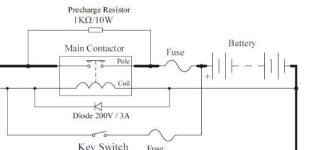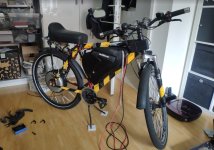Update Time!
I got two
7S 10AH packs
Chargery
25A Charger
and
BMS16T
First the bad: The charger pooped itself after just 5 min of 10A Charging, my Home fuse popped.
I was able to diagnose and repair it with help of Jason from chargery over two weeks sending mails back and forth. Great service! It turned out the PFC Circuit popped it's FETs because of a faulty resistor. Still, i'd rather have it work from the factory, but oh well.
The good:
This BMS is worth it's money except for one point: Balance current is 1.2A per cell. but it is temperature controlled and has a heatsink that is too small and inside an aluminium case. Balancing will take for ever on large capacities due to this.
i put a CPU heatsink with fan on it:
And Balancing was done in a breeze! (Jason mentioned a newer version coming out with a dedicated fan control port)
Otherwise it's nice - 2 Temp sensors, external shunt and relay, loads of configurability and balancing down to 3.6V (i think)
i fitted it in an
additive triangle bag. (no more bulky LiFe Packs, hooray!)
this now contains the batteries, BMS, fuse, shunt and contactor

Yesterday i was able to do a quick test drive - sadly the weather has been shit since then.
i pulled ~75A without notable sag and it goes quite well.
Question:
I have a LYEN MK2 18 Fet - how many amps can i push trough before the magic smoke escapes?
Anyone got expieriences ? - Lyen just told me back in the day:
he recommended maximum output for the 12 FET 4110 controller is around 3500 watts and the 18 FET controller is around 5250 watts. Power=V/I. So let say you are going to run 22S lipo at 81.4v nominal voltage. You then divide 3500 watts by 81.4v and you get around 43A for the 12 FET, 5250/81.4=64.5A for the 18 FET. Or for 24S is 3500w/88.8v=39.4A for the 12FET and 5250/88.8v=59A for the 18 FET.
that would equate to ~100A. Good idea?











